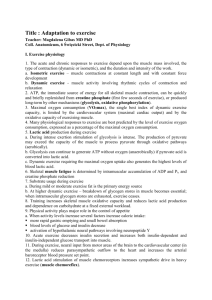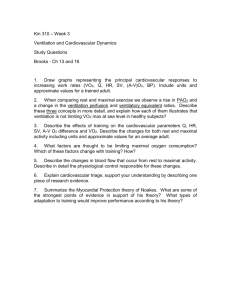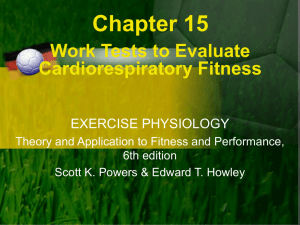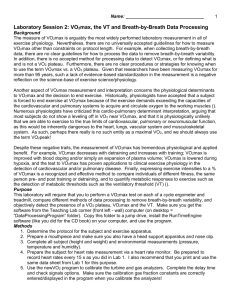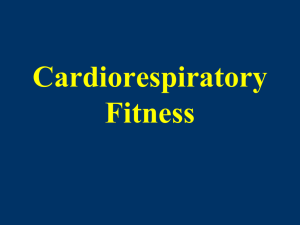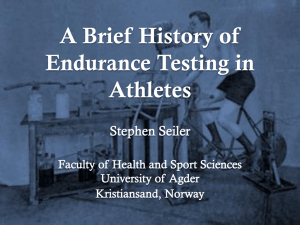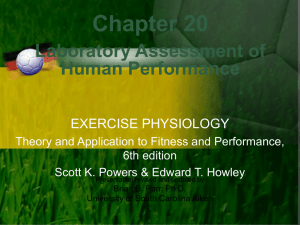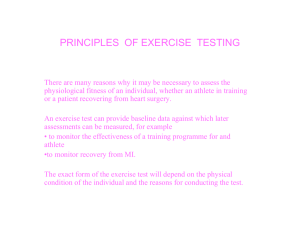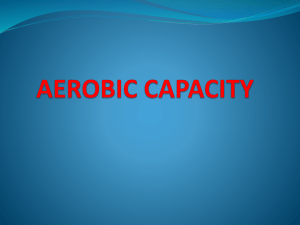Journal of Exercise Physiologyonline
advertisement
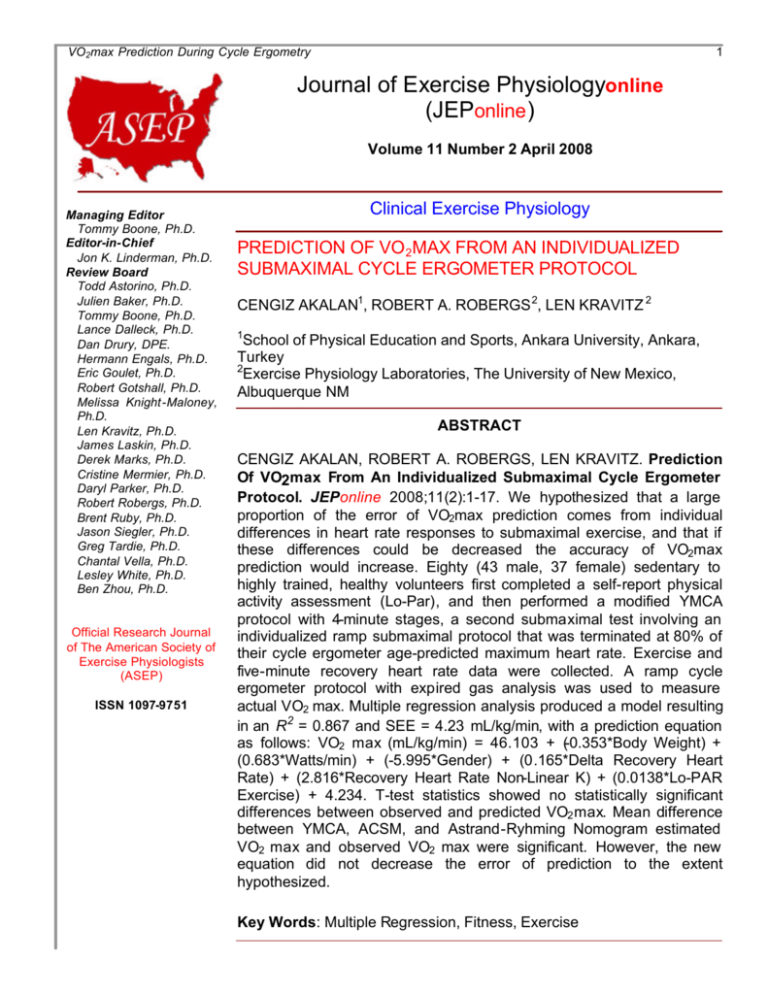
VO2max Prediction During Cycle Ergometry 1 Journal of Exercise Physiologyonline (JEPonline ) Volume 11 Number 2 April 2008 Managing Editor Tommy Boone, Ph.D. Editor-in-Chief Jon K. Linderman, Ph.D. Review Board Todd Astorino, Ph.D. Julien Baker, Ph.D. Tommy Boone, Ph.D. Lance Dalleck, Ph.D. Dan Drury, DPE. Hermann Engals, Ph.D. Eric Goulet, Ph.D. Robert Gotshall, Ph.D. Melissa Knight-Maloney, Ph.D. Len Kravitz, Ph.D. James Laskin, Ph.D. Derek Marks, Ph.D. Cristine Mermier, Ph.D. Daryl Parker, Ph.D. Robert Robergs, Ph.D. Brent Ruby, Ph.D. Jason Siegler, Ph.D. Greg Tardie, Ph.D. Chantal Vella, Ph.D. Lesley White, Ph.D. Ben Zhou, Ph.D. Official Research Journal of The American Society of Exercise Physiologists (ASEP) ISSN 1097-9751 Clinical Exercise Physiology PREDICTION OF VO 2MAX FROM AN INDIVIDUALIZED SUBMAXIMAL CYCLE ERGOMETER PROTOCOL CENGIZ AKALAN1, ROBERT A. ROBERGS 2, LEN KRAVITZ 2 1 School of Physical Education and Sports, Ankara University, Ankara, Turkey 2 Exercise Physiology Laboratories, The University of New Mexico, Albuquerque NM ABSTRACT CENGIZ AKALAN, ROBERT A. ROBERGS, LEN KRAVITZ. Prediction Of VO2max From An Individualized Submaximal Cycle Ergometer Protocol. JEPonline 2008;11(2):1-17. We hypothesized that a large proportion of the error of VO2max prediction comes from individual differences in heart rate responses to submaximal exercise, and that if these differences could be decreased the accuracy of VO2max prediction would increase. Eighty (43 male, 37 female) sedentary to highly trained, healthy volunteers first completed a self-report physical activity assessment (Lo-Par), and then performed a modified YMCA protocol with 4-minute stages, a second submaximal test involving an individualized ramp submaximal protocol that was terminated at 80% of their cycle ergometer age-predicted maximum heart rate. Exercise and five-minute recovery heart rate data were collected. A ramp cycle ergometer protocol with expired gas analysis was used to measure actual VO2 max. Multiple regression analysis produced a model resulting in an R2 = 0.867 and SEE = 4.23 mL/kg/min, with a prediction equation as follows: VO2 max (mL/kg/min) = 46.103 + (-0.353*Body Weight) + (0.683*Watts/min) + (-5.995*Gender) + (0.165*Delta Recovery Heart Rate) + (2.816*Recovery Heart Rate Non-Linear K) + (0.0138*Lo-PAR Exercise) + 4.234. T-test statistics showed no statistically significant differences between observed and predicted VO2 max. Mean difference between YMCA, ACSM, and Astrand-Ryhming Nomogram estimated VO2 max and observed VO2 max were significant. However, the new equation did not decrease the error of prediction to the extent hypothesized. Key Words: Multiple Regression, Fitness, Exercise VO2max Prediction During Cycle Ergometry 2 INTRODUCTION The measure of the maximal rate of whole body oxygen consumption during exercise (VO2max) has a history dating back to the pioneering work of A.V. Hill in the 1920s. Traditionally, VO2max has been interpreted as a measure of the maximal capacity of the cardiorespiratory system to acquire oxygen, circulate it to working muscle, where muscle can the extract and utilize oxygen in mitochondrial respiration to meet the energy needs of muscle contraction. The measure of VO2 max has therefore been invaluable in quantifying endurance fitness and the status of the cardio-respiratory and muscular systems for all individuals ranging from the athlete to the sedentary and diseased. As the measurement of VO2 max needs expensive equipment, and requires individuals to exercise to volitional fatigue, it is not suitable for use when testing a large number of individuals, or when individuals might be placed at an unacceptable health risk when exercising to maximal exertion. Consequently, numerous procedures have been researched and validated to estimate VO2max from submaximal exercise or procedures not involving exercise at all (Table 1-3). Type Table1. Summary of Treadmill VO2 max Tests. Study ACSM (Walking) (ml/kg/min) ACSM (Running) (ml/kg/min) Ebbeling (ml/kg/min) Treadmill Widrick (ml/kg/min) Wilmore (ml/kg/min) Bruce (Maximal) (ml/kg/min) Foster (Maximal) (ml/kg/min) Froelicher (Maximal) (ml/kg/min) Bonen (L/min) Metz (ml/kg/min) Metz (ml/kg/min) Hermiston Predictor Variables N Ages Gender/Health R SEE - - - - M, F Healthy M, F Healthy Grade, Time - - Grade, Time - - 67 20-59 72 - F Walk Speed, Age, HR, Gender 145 20-59 42 18-30 44 - 94 - 97 - 295 - 230 - 1,025 20-53 M Healthy M Healthy M Active M Sedentary M Cardiac M, F Healthy M Varied M Healthy 100 7-15 60 Walk speed, Age, HR, Gender 0.96 5.0 Weight, Age, Gender, Time, HR 0.91 5.26 Weight, Age, Gender, Time, HR 0.76 5.0 Time 0.906 - 3.298 (time) + 4.07 0.906 - 2.327 (time) + 9.48 0.865 - Gender, Time 0.920 - Time 1, Time2, Time3 0.977 3.35 Time 0.72 4.26 M HR, VCO2, VO2, Age 0.95 0.170 12-13 M HR, VO2, RER 0.70 - 60 14-15 M HR, VO2, RER 0.48 3.8 28 25-45 M Age, FFV, HR, Fe CO2, V T, RER 0.90 - M VO2max Prediction During Cycle Ergometry 3 Type Table2. Summary of Cycle Ergometer VO2 max Tests. Study Cycle Ergometer ACSM (ml/min) ACSM (L/min) Latin (ml/min) Legge (L/min) Wasserman (ml/min) Fox (ml/min) Astrand (L/min) Siconolfi (L/min) Legge (L/min) Patton (Maximal) (ml/min) Storer (Maximal) (ml/min) Mastrapaolo (L/min) Siconolfi (L/min) N Ages Gender/Health - - - - 110 18-38 15 20-29 10 - - - M, F Healthy M, F Healthy M Healthy M Trained M Untrained - 87 17-27 M 27 18-30 31 - 25 20-70 28 - 25 20-29 15 - 12 - 115 20-70 116 - 13 43-61 M Healthy F Healthy M Healthy F Healthy M Healthy M Healthy F Healthy M Healthy F Healthy M 63 20-70 M, F Predictor Variables R SEE Kg/min, Weight - - Watts - - Kg/min, Weight 0.96 154.0 ?HR (max HR-zero load HR) - 0.39 ?HR (max HR-zero load HR) - 0.32 Watts - - HR-at5th min at 150 Watts 0.76 246.0 Nomogram - 0.28 Nomogram - 0.27 0.86 0.36 VO2; Astrand, Age 0.97 0.20 Nomogram using ?HR (max HR- zero load HR) Watts 0.98 0.17 0.89 - Watts 0.88 - Max Watts, Weight, Age 0.94 212.0 Max Watts, Weight, Age 0.93 147.0 0.93 0.172 0.94 0.248 VO2; Astrand, Age RER, DBP, VE, Fe O2, Work (kpm) Age, VO2 predicted from Astrand Nomogram Assessment of the research summarized in Table 1-3 reveals the frequent use of exercise heart rates in VO2max prediction. Although the HR response to any given workload has been shown to roughly reflect the physical working capacity of an individual, there are limitations associated with the use of HR as a single independent variable to estimate VO2max. For instance, Davies et al. (1) notes that VO2max is consistently under-estimated due to the asymptotic, rather than linear, pattern of the HR response as one approaches VO2max. Another problem with these methods is the assumption required for a target maximal HR using age as the only predictor variable. Many laboratories report standard deviations for age-predicted maximal HR in the order of 10-15 beats/min (2). Thus, the estimated maximal HR is accurate for some, while either high, or low for an unacceptably large proportion of other individuals. Ultimately, such a large standard deviation has the effect of reducing the precision with which VO2max can be predicted from submaximal HR. VO2max Prediction During Cycle Ergometry 4 Non-exercise equations Field Tests Bench Stepping Type Table3. Summary of Field VO2 max Tests. Study N Ages Gender/Health ACSM (ml/kg/min) McArdle (ml/kg/min) - - 41 18-22 - 18-22 24 15-74 M, F Healthy F Healthy M Healthy F 35 15-74 M 115 17-52 M 343 18-23 M, F Coleman (ml/kg/min) 90 20-29 M, F Healthy Doolittle Getchell Ribisl (ml/kg/min) Ribisl (ml/kg/min) Kline (L/min) 9 21 24 14-15 18-25 30-48 M F M 11 18-22 M 343 30-69 M, F 2417 M 384 F 21-82 M,F 60 M 21- Jette (ml/kg/min) Jette (ml/kg/min) Cooper (ml/kg/min) Kline (L/min) Wier (ml/kg/min) Sanada (L/min) M Predictor Variables Steps/min, Height R SEE - - Recovery HR 0.92 Recovery HR - - - 4.1 - 4.1 Age, Weight, VO2, Recovery HR Age, Weight, VO2, Recovery HR 35.97(miles after 12 min) 11.29 Weight, Age, Gender, Time, HR 2.9 0.90 - 0.93 0.325 Weight, Age, Gender, Time-1mile walk, HR 0.79 5.68 12-min run/walk distance 1.5-mile run time Age, Weight, 00 yards, 200 yards, 2-mile run time Age, Weight, 00 yards, 200 yards, 2-mile run time 1-mile walk time, Age, HR, 1-4 weight 0.90 0.46 0.95 1.97 0.94 1.55 0.93 0.325 Waist Girth 0.81 4.80 % Fat 0.82 4.72 BMI 0.80 4.90 Lower Leg Skeletal Muscle Mass Left Ventricular Internal Dimension at End-diastole Left Ventricular Internal Dimension at End-systole Stroke Volume 0.55 - 0.74 - 0.72 - 0.72 - Of the numerous predictive equations reported in the literature, most do not present cross-validation results (3-7), many were developed on age/sex specific populations (5,8-11), and several provide none or high values of the standard error of the estimate (SEE) measure which reflects the inaccuracy of VO2max prediction (12-28). The purpose of developing prediction equations is to provide a simpler means of determining a complex measurement by using variables that are easily measured. The selection of important variables that are likely to influence the VO2max, along with good research techniques and equipment, are important factors that affect the validity of the prediction equation (29). To develop better prediction equations, researchers need to complete measurements on a large number of VO2max Prediction During Cycle Ergometry 5 individuals and use variables likely to influence the criterion. In this case, we hypothesized that if the estimate of maximal heart rate is not used in prediction, and replaced with individualized assessments of the heart rate responses to incremental exercise and recovery, improved accuracy of VO2max prediction should result. Therefore, given the importance of the prediction of VO2max from submaximal exercise, and the fact that no precise method of VO2 max estimation exists, the primary purpose of this study was to develop an accurate and easy- to-use multiple regression equation to predict VO2 max in men (< 40 yrs) and women (< 50 yrs) from an individualized submaximal cycle ergometer protocol. A secondary purpose of this study was to compare the accuracy of the new prediction equation with other commonly used prediction equations. METHODS Subjects Forty-three males (18-39 yr) and thirty seven females (18-49) who were sedentary to highly trained volunteers were recruited from the student body of a large urban university and from the surrounding community. Before participating in the study, the subjects completed a health history questionnaire, and a consent form approved by the university’s human subjects review board. All subjects were non-smokers, apparently healthy and familiar with cycle ergometer exercise. Subjects were taking no medications and were free from cardiovascular and/or respiratory disease at the time of the study. Because of the maximal exertion required for the maximal cycle ergometer test, an age limit was imposed (male ≤ 39 years, female ≤ 49 years, all subjects > 18 years) based on the requirements of the university human subjects review board. Prior to reporting to the laboratory for the testing, subjects were given the following instructions: no eating, drinking (except water) within three hours, caffeine ingestion within twelve hours, and no heavy exercise within 18 hours prior to testing. All testing was performed at an altitude of 1540 meters and all subjects were residents of altitudes between 1350 – 1850 m for more than one year. Table 4. Descriptive data for the sample with demographics, criterion, and predictor variables. Variables Age (years) Height (cm) Weight (kg) Observed VO2 max (ml/kg/min) Body Fat (%) Lo-PAR total (MET/hr/wk) Lo-PAR exercise (MET/hr/wk) HR rest (beats/min) Predicted maximal HR (beats/min) % 80 predicted maximal HR (beats/min) SM2 minute watt increase (Watts/min) SM2 exercise average HR (beats/min) SM2 exercise HR/Time Linear Slope (value) SM2 recovery ? HR(highest -lowest) (beats/min) SM2 recovery HR/time non-linear K (value) SM2 recovery HR/time non-linear Half time (value) Male n=43, Female n=37 ) Mean Range 19-49 27.8±8.0 152.7-197.3 172.1±9.1 51.3-113.3 70.4±13.7 24.07-64.53 44.21±8.1 3.75-43.02 20.62±8.4 238.05-424.01 312.79±50.4 0.50-207.0 70.77±43.9 43-82 63.98±8.6 166.7-188.3 181.6±5.9 133-151 145.6±4.6 15-45 25.3±6.8 81-129 106.08±10.3 7.09-16.99 10.82±2.1 13-93 59.3±14.9 0.4446-3.0520 1.3377±0.52 0.1519-1.5590 .5897±0.24 VO2max Prediction During Cycle Ergometry Heart Rate (beats/min) a 170 150 130 110 90 70 50 Heart Rate (beats/min) 0 1 2 3 4 5 6 7 8 9 10 11 12 13 1415 16 170 b Time (min) Procedures All questionnaires, health screening, anthropometric measurements, and physiological testing were completed in one session. When the participants reported to the laboratory, they were verbally informed of the procedures and possible discomforts and risks of the study. Following the completion of the medical history questionnaire, subjects were told if they were eligible to participate and were asked to read and sign an informed consent. After signing the consent, the Modified Physical Activity Recall Questionnaire (Lo-PAR) (30,31) was administered and completed by the participants. The total scores and exercise section scores of the Lo-PAR were recorded as predictor variables for subsequent statistical analysis. 150 130 110 90 70 50 0 1 2 3 4 5 6 7 8 9 10 11 12 13 1415 16 Heart Rate (beats/min) 6 170 c Time (min) 150 130 110 90 After signing the consent, subjects were weighed in athletic apparel without shoes on a calibrated digital scale (Seca Corporation, Model # 707, Columbia, Maryland, USA) to the nearest 0.1 kg. Height measurements were obtained barefooted at midexpiration and recorded to the nearest 0.5 cm using a stadiometer (Accu-Hite Stadiometer, Seca Corporation, Columbia, Maryland, USA). Skinfold thickness was measured to the nearest 0.5 mm using a Lange caliper (Cambridge Scientific Industries, Columbia, Maryland, USA). All measurements were taken on the right side of the body using anatomical sites according to the Jackson and Pollock (32,33) three-site equations for both men and women. Skinfold measurements were performed until two were within 10% of each other. The equations developed by Heyward and Stolarczyk (34) were used to convert body density to % body fat for men and women. 70 50 0 1 2 3 4 5 6 7 8 9 10 11 12 13 1415 16 Time (min) Figure 1. Examples of raw data from a representative subject for a) a ramp cycle ergometer to VO2max and 6 min of recovery, b) the YMCA submaximal 4 min stage protocol, and c) an individualized ramp protocol to 80% predicted VO2max. Submaximal And Maximal Cycle Ergometer Tests Each subject performed two submaximal and one maximal cycle ergometer tests using a Lode (Excalibur Sport, Corval Lode B.V., Lode Medical Technology, Groningen, Netherlands) constant-load (cadence independent) cycle ergometer. Initially, subjects rested for 5 minutes prior to the measurement of resting HR. Seat height and handlebars were adjusted to fit the subject prior to each test. HR and electrocardiogram readings for all tests were monitored and recorded continuously (Biopac, CA) using a 3-lead ECG configuration. VO2max Prediction During Cycle Ergometry 7 Submaximal Test 1- YMCA Test Protocol (SM1) The original YMCA protocol (35) uses three or four consecutive 3-minute work loads. However, we modified the YMCA protocol to extend to 4-minute stages in order to more accurately detect steady state HR. Subjects performed cycler ergometry at a cadence of 50 rev/min, and the initial work load was 25 Watts. The heart rate during the last 15 seconds was used to determine subsequent work loads (if HR <80 beats/min:125 Watt; 80 to 90 beats/min:100 Watt; 90 to 100 beats/min:75 Watt; and >100 beats/min: 50 Watt). The test was terminated when two workloads were completed with heart rates between 110 and 150 beats/min. The subjects rested approximately 15 minutes before completing the second submaximal test. Submaximal Test 2- Individualized 1-minute Step Cycle Ergometer Test Protocol (SM2) After 15 minutes rest, when the subject’s resting HR was within 5-10 beats/min of their recorded resting HR value, the second 1-minute step submaximal test was started. Subjects completed two minutes of warm-up cycling with no resistance. HR was obtained continuously. The workload was increased by 15-45 Watts/min based on the previous sub-maximal test’s estimated VO2max results. When subjects reached 80% of their age-predicted maximum heart rate ([202-0.72 x (age)] x .80) (36), the exercise intensity was decreased to 25 Watts and the subject continued to exercise for active recovery HR data collection. Maximal cycle ergometer test After 15-20 minute rest, when the subjects’ resting HR reached about 5-10 beats/min of the initially recorded resting HR, the maximal cycle ergometer VO2 test with expired gas analysis was started. The metabolic analyzers were calibrated prior to each test for every subject. For collection of VO2 max data, an incremental ramp protocol using the same Watt/min increment from the previous step submaximal protocol. After measuring resting expired gases for 2 minutes, the protocol was started using a pedal rate of 70 rev/min. During the exercise test, VO2, VCO2, V E, and respiratory exchange ratio (RER) were collected breath-by-breath using a fast response turbine flow transducer (K.L. Engineering Model S-430, Van Nuys, CA) and custom developed software (LabVIEW, National Instruments, Austn, TX) with AEI oxygen and carbon dioxide electronic gas analyzers (AEI Technologies, Model S-3A and Model CD-3H, Pittsburg, PA). Raw signals were acquired through a junction box connected to a PC computer and integrated with a data acquisition card (National Instruments, Austin, Texas). HR and electrocardiogram readings (Quinton 4000, Quinton, Seattle, WA) using a 3-lead ECG configuration were recorded continuously as a five -beat average via electronic integration by the custom developed hardware and software. VO2 was considered maximal if the two of the following three criteria were achieved: 1) leveling of oxygen consumption despite an increase in work load; 2) respiratory exchange ratio (RER) = 1.1; and 3) HR within 15 beats of the age-predicted maximal HR. Data Processing and Creation of Variables From SM1 For the calculation of estimated VO2max, HR was plotted against work (Watts) on a graph by drawing a line connecting the heart rates and extrapolating to the subject’s age-predicted maximum heart rate [202-0.72 x (age) beats/min] (33) and followed by dropping a vertical line from the maximal heart rate to the x-axis. This point represented the estimated maximal power (Watts) at VO2max. Then, the corresponding estimated VO2max was calculated from watts using the following equation: VO2max (ml . min-1) = (Watts x 6 kpm/Watt) x 2 ml/kpm +300 (32). In addition, estimated VO2 max for ACSM and Astrand-Ryhming Nomogram were calculated for each subject from the YMCA’s steady-state HR and workload data. VO2max Prediction During Cycle Ergometry 8 From SM2 In order to create an individualized protocol, the estimated Watt increases for every minute of the 1minute step cycle ergometer test protocol were determined from the submaximal YMCA test (Equaton 1). Watt Increase/min = [YMCA Estimated VO2 max (L/min) x1000 / 11 mL/min/Watta] / 12 minb + 5 Wattc Equation 1 The VO2 Watt cost approximates 11 mL/min/Watt (37). For the VO2 max test to end within 10-12 minutes, we divided the peak Watts estimate by 12 to get a Watts/min ramp function. However, as incremental exercise has an increasing energy component from the phosphagen and glycolytic systems during the second half of the protocol, several pilot tests revealed the need to add 5 Watts to the final Watt/min ramp function. Submaximal exercise and recovery HR and workload data were used to determine the relationship between HR response and workload increase during exercise and recovery. Variables developed from this data included linear and non-linear regression slopes for HR and time, and recovery average and recovery delta (highest-lowest) HR (Prism, Graphpad Software, San Diego, CA). Heart Rate (beats/min) From Maximal test Maximal HR, VO2, VCO2, V E, and respiratory exchange ratio (RER) were determined by averaging last 15 seconds of recorded data, centered around the peak breath-by-breath value. 140 125 110 K = 1.304 Figure 2. Recovery heart rate data for a representative subject after the STEP test. 95 80 65 50 6.5 7.5 8.5 9.5 10.5 11.5 12.5 Time (min) Statistical Analyses All data were analyzed using SPSS (Statistical Package for Social Sciences, version 11.1, Chicago, IL). Diagnostic tests were performed to detect missing, influential and/or outlying observations, of which none were found. In addition, all necessary data problem checking procedures were performed (distribution, normality, homogeneity, independence of error, linearity, and collinearity). Standard descriptive statistics (means, standard deviations, range) were used to present the characteristics of the subjects for all variables. The alpha level was set at p<0.05 for all analyses. An hierarchical variable entry method was performed to obtain the best model for estimating relative (ml/kg/min) VO2 max. The variables initially used to select the best subsets were: age, gender (GND), height, weight (BW), % body fat (BF), Lo-PAR total score (LPTOT), Lo-PAR exercise score (LPEXER), heart rate rest (HHR), predicted maximal heart rate (PMHR), 80% predicted maximal heart rate (PRCHR), as well as step increment protocol’s watt increase/min (MS2 WTIN), exercise average heart rate (MS2 EAHR), exercise heart rate vs time linear regression slope (MS2 LRSP), delta recovery heart rate (highest-lowest) (MS2 DRHR), and recovery heart rate vs time non-linear VO2max Prediction During Cycle Ergometry 9 regression (one phase exponential decay) rate constant (MS2 RHRNK) and Half Time value (MS2 RHRNHT) (Prism, Graphpad Software, San Diego, CA). Generalized (gender-independent) and gender-specific equations were developed from the data to predict VO2max. To determine the correlation and mean differences between actual and predicted VO2 max, the Pearson Product Moment Correlation and Paired Sample t-test were also performed. In addition, for the secondary purpose of this study, estimated VO2 max was calculated for each subject from this investigation’s new equations, YMCA, ACSM, and Astrand-Ryhming Nomogram. One-way analysis of variance (ANOVA) was used to determine if VO2max predictions different between methods. RESULTS Raw Data Examples of raw data from a representative subject for the heart rate responses for the three exercise and recovery tests are presented in Figure 1a-c. Figure 2 presents the method of modeling the recovery heart rate data for mono -exponential curve fitting to derive the rate constant variables. Predicted VO2 max (ml/kg/min) Gender-specific equations developed from the data did not explain more variance than the generalized equation, so subsequent discussion will include only the gender- independent equation. Table 2 presents the means, standard deviations, and ranges for the demographic characteristics of the sample as well as the criterion and all independent (predictor) variables used in the multiple regression procedure. 70 60 Figure 3. The relationship between measured VO2max and predicted VO2max using the multiple regression equation as presented in the text 50 40 30 20 20 30 40 50 60 70 Measured VO 2 max (ml/kg/min) Regression Equation Derived From The Sample A two-step regression procedure was applied to obtain the best model for the prediction equation. For the first step, all predictor variables were entered simultaneously into the model to evaluate their unique contribution to the overall regression model and to the observed VO2max. Using all predictor variables, this regression model resulted in an R2 = 0.761, an adjusted R2 = 0.700, and standard error of the estimate (SEE) = 4.47 (ml . kg-1. min-1). The Durbin-Watson test was also calculated to evaluate if the independence of error assumption in the regression model was met. The value was 2.30, which indicated that this assumption was met. The standardized ß indicates the magnitude of the unique contribution that each predictor variable makes to maximally predicting the observed VO2max in the regression model. Only five variables (SM2 Watt/minute increase, weight, gender, SM2 recovery delta HR, and SM2 recovery HR non-linear K value) made a significant contribution to the prediction model according to the t values for each ß coefficient. VO2max Prediction During Cycle Ergometry 10 For the second step, an hierarchical multiple regression variable entry method was used by entering all four previously determined significant variables as the first block of variables and then entering other non-significant variables block by block into the regression model. Several regression equations were obtained to predict VO2 max, and from those, the most efficient prediction model was selected. This equation was the one that required the least time to complete and the fewest variables to monitor, yet retained accurate estimates of VO2 max with a low SEE (<5 ml/kg/min). The model summary, set of predictor variables, and inter-correlations among predictor variables as well as the observed VO2 max from the selected best model are presented in Tables 5-7. The prediction equation derived from the data was as follows: VO2 max (ml/kg/min) = 46.103 + (-0.353BW) + (0.683 MS2 WTIN) + (-5.995 GND a) + (0.165 MS2 DRHR) + (2.816 MS2 RHRNK) + (0.0138 LPEXER) + 4.234 a. Coded as Male=1 Female=2 Table 5. The model summary of the hierarchical regression procedure. Model R 2 R 2 Adj. R SEE 1 F Change 36.774 Sig. F Change .000 DurbinWatson 2.304 .731 4.234 .867a .751 a. Predictors: (constant), SM2 minute watt increase, weight, gender, SM2 recovery delta HR, SM2 recovery HR/time non-linear K value, Lo-PAR Exercise score b. Dependent variable: Measured VO2max Table 6. Set of predicted variables from regression procedure. Predictors B (Constant) Weight SM2 minute watt increase Gender SM2 recovery ? HR(highest -lowest) SM2 recovery HR/time non-linear K value Lo-PAR exercise a. Dependent Variable: Measured VO2max 46.103 -0.353 0.683 -5.995 0.165 2.816 0.0137 ßa -0.595 0.570 -0.386 0.302 0.182 0.074 t 9.181 -7.499 6.658 -4.760 4.505 2.905 1.129 ? .001 .001 .001 .001 .001 .005 .263 Table 7. Inter-correlations among predictor variables and the observed VO2max. 1 2 3 4 5 6 7 Predictor Observed VO2max Weight SM2 minute watt increase Gender SM2 recovery ? HR(highest -lowest) SM2 recovery HR/time nonlinear K value Lo-PAR exercise 1 1.000 2 -0.105 1.000 3 0.563 0.550 1.000 4 -0.369 -0.533 -0.506 1.000 5 0.607 0.046 0.421 -0.234 1.000 6 0.095 -0.231 -0.122 0.348 -0.073 7 0.417 0.110 0.399 -0.311 0.263 1.000 -0.072 1.000 There was a significant correlation between actual and predicted VO2max (r= .867, p< 0.0001), and paired sample statistics showed no statistically significant difference between measured and predicted VO2max. (t=1.156, SD=4.07, p=0.99). Predicted versus measured VO2 max values are plotted in Figure 3. VO2max Prediction During Cycle Ergometry 11 Comparisons Of Commonly Used Prediction Equations One-way analysis of variance (ANOVA) was used to determine the mean differences between the study results for the YMCA, the ACSM, and the Astrand -Ryhming Nomogram’s estimated VO2 max, and the actual measured VO2 max. Means, standard deviations, and ranges for all four estimation equations and observed VO2 max are presented in Table 8. One-way analysis of variance showed a significant (p<0.0001) difference in the actual VO2 max and estimated VO2 max from the YMCA equation, the ACSM equations, and the Astrand-Ryhming Nomogram. However, the mean difference between this study’s equation’s estimated VO2 max and observed VO2 max was not significant. (F (4,395) = 13.12, MSE=68.7, p=0.97, N=80). Results also showed that YMCA, ACSM, and AstrandRyhming Nomogram underestimated true VO2 max. ANOVA results and Tukey HSD multiple comparisons are presented in Table 9 and 10. Means of predicted and measured VO2 max scores were plotted in Figure 4. Table 6. Means, standard deviations, and ranges for all four estimation equations and observed VO2 max. Observed VO2 max (ml . kg-1 . min-1) YMCA Equation ACSM Equation Astrand-Rhyming Nomogram Study’s new equation (N=80) Mean SD Range 44.22 8.1 24.07-64.53 38.77 36.88 40.05 44.20 8.9 8.6 8.4 7.1 17.91-57.20 17.61-56.77 21.58-59.85 25.20-60.07 Table 7. ANOVA results (N=80). Mean Between Groups Within Groups Total p< 0.05 Sum of Squeres 3609.129 27153.339 30762.468 df 4 395 399 Mean Square 902.282 68.743 F 13.126 Sig. <.001* Table 8. Tukey HSD Multiple comparisons between new equation,s, the YMCA’s, the ACSM’s, and the Astrand-Ryhming Nomogram’s estimated, and the actual measured VO2max. (N=80) Observed VO2 max (ml . kg-1 . min-1) YMCA equation ACSM Equation Astrand-Rhyming Nomogram Study’s new equation Mean diff. -- Standard Error Sig 5.84 7.33 4.16 1.31 1.31 1.31 <.001* <.001* <.001* .002 1.31 1.000 * p< 0.05 DISCUSSION Maximal oxygen uptake can be predicted with reasonable precision (R=0.867, SEE=4.23 ml/kg/min) from individualized submaximal cycle ergometer test data using multiple regression equations. Lewis et al. (38) showed that variations in VO2max with different forms of exercise generally reflect the quantity of muscle mass activated. Studies that determined VO2max for the same subjects during different exercise modes indicate that treadmill exercise usually produces the highest values VO2max Prediction During Cycle Ergometry 12 (39).Treadmill exercise proves highly desirable for determining VO2max in healthy subjects in the laboratory. Most studies show that VO2 max measured on a cycle ergometer is 10% to 15% less than that measured on a treadmill (40). Swain and Wright (41) found that cadences between 50 and 80 rev/min were equally valid for predicting VO2max from submaximal cycle ergometer. We selected 70 rpm as a conservative median value to use for this study. VO2max (mL/kg/min) 60 * * * AR YMCA ACSM 45 30 15 0 VO2 max New Figure 4. Mean±SD data for VO2max that was measured and predicted from the different methods identified in text. VO2max=as measured in this study; YMCA=YMCA equation; ACSM=ACSM equation; AR=Astrand-Rhyming nomogram; New=from prediction equation of this study. *= different (p<0.05) from measured. Method Studies in which advantages and disadvantages of various exercise modes and protocols have been discussed reported that an ideal protocol should consider the following: 1) the purpose of the test; and 2) the subject tested (42). For most exercise tests, however, the choice of protocol is directed by tradition, equipment, or convenience. The need to maintain a test duration of 12 minutes sug gests that increments in intensity will be different for individuals of differing cardiorespiratory fitness. This fact stresses the need to tailor a protocol to suit a given individual. Therefore estimation of a person’s cardiorespiratory fitness, habitual physical activity level, and training history are important first steps in determining a protocol for testing. This estimation can then be applied to different testing procedures (29) This study employed a modified physical activity questionnaire called Lo-PAR to estimate habitual exercise level of the subjects. The Lo-PAR exercise score was used in the regression model to predict VO2max and it was one of the most meaningfull predictor variables that contributed to the exploration of between subject variance in VO2max. Declining physical activity appears to be a major factor, along with the loss in fat-free mass and increase in fat mass, in describing the decline in VO2max in adult and older persons (43). In addition, prolonged inactivity has many detrimental effects on the skeletal muscles and the cardiovascular system. For example, bed rest leads to a decrease in VO2max of 0.8% per day (44). Research has shown that the rise in aerobic power with training is just as rapid as its fall without it, and most of the improvements in VO2max occur within three weeks of beginning intense (3-4 times a week, moderate to high intensity) cardiorespiratory training. In addition, once the desired VO2max is achieved, it is possible to maintain it by reducing the frequency and maintaining the intensity of training (45). Based on this information concerning effects of training and high level of physical activity, it is not surprising that Lo-PAR exercise was selected as an important predictor variable in the current study’s equation. One obvious shortcoming of the approach described in this study was the use of two tests instead of one. The first test (SM1) was performed for one purpose: to estimate subject’s peak Watts at the level of maximal oxygen consumption through an easy-to-use cycle ergometer protocol and therefore, to VO2max Prediction During Cycle Ergometry 13 evaluate how accurately a targated test duration and intensity could be attained using the individualized approach. The minute Watt increase which is individually determined for every subject in this study was identified as a significant predictor by the regression model to predict of VO2max. Gender-specific equations developed from the data (R=.843, SEE 4.87 for male, and R=.835, SEE 5.54 for female) did not explain more variance than the generalized equation, so subsequent discussion will include only the gender independent equation. The lower explained variance and higher SEE from the gender-specific regression model most likely due to the smaller sample size (male 43, female 37). While the absolute VO2 (L/min) for treadmill exercise at any given work rate is substantially affected by body weight, such is not the case in cycle ergomete r exercise since the body weight is supported by the seat. However, Wasserman and Whipp (46) have reported that VO2 is influenced by the subject’s body weight even in the weight-supported cycle exercise due to the differences in the O2 cost of moving large leg muscles; for any given work rate, they found that VO2 was 5.8 mL/min higher for each additional kilogram of body weight. It can be clearly seen from Table 1 that body weight and gender are significant predictor variables in other studies. This is true in the present investigation. The most striking difference between the regression equation generated from the present data set and previously reported regression equations is the inclusion of subject’s recovery HR response as a significant predictor of VO2 max. As presented in Table 1, only McArdle’s and Jette’s gender-specific prediction equations uses the recovery heart rate as a predictor variable in the equation. McArdle clearly stated that their step test recovery HR provided significant information about VO2max. They found that subjects with high recovery HR and a slow decrease pattern tended to have a lower VO2 max whereas a faster recovery (faster reduction, lower HR) related to relatively high VO2 max values. Similarly recovery delta (highest-lowest) HR and recovery HR/Time non-linear (one phase exponential) statistics K value from this study were selected as important predictor variables in the regression model. Age was not an important predictor in our regression model. Functional capacity of an individual declines after the age of 30 yrs, with deterioration varying at any age depending on various conditions, especially lifestyle characteristics (39). The subject’s mean age was 27.8 and Lo-PAR scores indicated that 95 % of the subjects were inactive to very active (>250 MET/hr/week) with only 5% were in the less active category. Having young subjects who have active to very active lifestyles may be the underlying reason for this result. The Astrand-Ryhming Nomogram (47) assumes a linear relationship between heart rate (HR) and oxygen consumption. Based on this assumption, an extrapolation of the HR response to a submaximal workload on a cycle ergometer is used to estimate VO2 max. Glassford et al. (48) and Teraslinna et al. (49) used an age-correction factor in conjunction with the nomogram and found a correlation between measured and estimated VO2 max of 0.92 and 0.80, respectively. Davies (1) showed that the Astrand-Rhyming Nomogram consistently underestimated VO2max. In the 4th edition of its Guidelines text, the ACSM submaximal bicycle test (50) consisted of multiple (generally 3 or 4) two-minute stages designed to have the subject approach a heart rate of 70% of age predicted maximum. In its 5th edition Guidelines, the ACSM modified its bike test protocol to make the stages 3 minutes in length. Swain and Wright (41) evaluated this test and found that this method also overestimated the actual VO2max by 28% on average. They concluded that the length of the stages in the ACSM protocol may be the principal reason for the overestimation of VO2 max. If VO2max Prediction During Cycle Ergometry 14 higher HR were obtained for a given workloads, the extrapolated values of estimated maximal workload and estimated VO2max would be lower, and thus, might not be overestimated. A similar test commonly used for fitness screening is the submaximal cycle ergometer test outlined by the YMCA, in which work is incremented based on the HR response to a submaximal level (32). Although the HR response to any give n workload has been shown to roughly reflect the physical working capacity of an individual, there are limitations associated with the use of HR as a single independent variable to estimate VO2max. Another problem with these methods is the assumption required for a target maximal HR using age as the only predictor variable. Many laboratories report standard deviations for age-predicted maximal HR in the order of 10-15 beats/min (2). Tables 1, 2 and 3 contain summaries of predictor variables, correlation coefficients, and SEE of most prior research of VO2max prediction equations. When several equations were presented by other studies, the equation which yielded the highest R and the lowest SEE was selected for comparisons. It is apparent from these tables that the multiple regression equation derived from this study with a 0.867 R value, 75% explained variance, and 4.234 (mL/kg/min), and 0.29 (L/min) SEE is more accurate than most of the other prediction equations, especially those using nomograms as a prediction tool. The primary reason for the greater accuracy of the prediction found in this study is likely due to the individulized submaximal protocol approach. In this approach, SM1 was used to determine the best watt increment for the SM2 and the use of 4-minute stages rather than 3-min stages may have allowed the subject to reach a true steady-state HR. If a steady-state HR is not achieved at submaximal stages of SM1 of YMCA protocol, then the recorded HR will be low, resulting in an overprediction of the workload. Therefore, it was expected that the longer stage length used in SM1 would (and did) result in greater accuracy in minute watt increase in SM2 protocol and therefore a significantly higher contribution to VO2max prediction from SM2 data. Under these circumstances, it is not surprizing that the mean difference between the YMCA’s, the ACSM’s, and the Astrand-Ryhming Nomogram’s estimated VO2max and observed VO2max were significant, whereas the mean difference between this study’s equation’s estimated VO2 max and observed VO2 max was not significant (Table 8, Figure 4). CONCLUSIONS The use of multiple regressions with a hierarchical variable entry method proved to be an effective method of developing a satisfactory submaximal cycle ergometer prediction equation. The technique of this multiple regression allows the inclusion of additional determinants of VO2max if more precise estimate is required. Equations such as the one presented in this study should be tested on multiple populations to discern its validity in these special populations. The application of the equation and methods of testing used in this study to include individuals in clinical settings may enhance and expand it’s utility as a valuable tool for classifying exercise capacity and exercise prescription in a broad range of individuals. Address for correspondence: Robert A. Robergs, Director: Exercise Physiology Laboratories, Exercise Science Program, Department of Physical Performance and Development, Johnson Center Room B143, The University of New Mexico, Albuquerque, New Mexico, 87131. Phone: (505) 2772658; FAX: (505) 277-9742; Email: rrobergs@unm.edu REFERENCES VO2max Prediction During Cycle Ergometry 15 1. Davies CTM. Limitations of maximum oxygen intake from cardiac frequency measurements. J Appl Physiol 1968; 24:700-706. 2. Froelicher VF, Myers J, Follansbee WP, & Labovitz AJ. Exercise and Heart. St. Louis, MO: Mosby-Year Book. 1993. 3. Falls H, Ismail AH, & Macleod DF. Estimation of maximum oxygen uptake in adults from AAHPERD Youth Fitness test items. Res Quart 1966; 37:192-201. 4. Ribisl PM & Kachadorian WA. Maximal oxygen intake prediction in young and middle-aged males. J Sports Med 1969; 9:17-22. 5. Fox EL. A simple accurate technique for predicting maximal aerobic power. J Appl Physiol 1973; 35:914-916. 6. Jette M, Campell J, Mongeon J, & Routhier R. The Canadian Home Fitness Test. Can Med Assoc J 1976; 114:680-683. 7. Mastropaolo JA. Prediction of maximal O2 consumption in middle -aged men by multiple regressions. Med Sci Sports Exerc 1970; 2:124-127. 8. Bonen A, Heyward VH, Cureton KJ, Boileau RA, & Massey BH. Prediction of maximal oxygen uptake in boys, ages 7 -15 years. Med Sci Sports Exerc 1979;11: 24-29. 9. Jessup GT, Tolson H, & Terry JW. Prediction of maximal oxygen intake from Astrand-Rhyming test, 12-minute run, and antropometric variables using stepwise multiple regressions. Am J Phys Med 1974; 53:200-207. 10. McArdle WD, Katch FI, Pechar GS. Reliability and interrelationships between maximal oxygen intake, physical work capacity and step-test scores in college women. Med Sci Sports Exerc 1972; 4:182-186. 11. Metz KF & Alexander JF. Estimation of maximal oxygen intake from submaximal work parameters. Res Quart 1971; 42:187-193. 12. Cooper KH. A means of assessing maximal oxygen intake, JAMA 1968; 203:201-204. 13. Kline KM, Porcari JP, Hintermeister R. Estimation of VO2max from a one-mile track walk, gender, age and body weight. Med Sci Sports Exerc 1987; 19:253-259. 14. Doolittle T. & Rigbee R. The twelve-minute run-walk: A test of cardiorespiratory fitness of adolescent boys. Res Quart 1968; 39:491-495. 15. Getchell LH, Kirkendall D, & Robbins, G. Prediction of maximal oxygen uptake in young adult women joggers. Res Quart 1977; 48:61-67. 16. Hermiston R, & Faulkner JA. Prediction of maximal oxygen uptake by a step-wise regression technique. J Appl Physiol 1971; 30:833-837. 17. Widrick J, Ward A, & Ebbeling C. Treadmill validation of an over-ground walking test to predict peak oxygen consumption, Eur J Appl Physiol 1992; 64:304-308. 18. Ebbeling CB, Ward A, & Puleo EM., Widrick, J., & Rippe, J.M. Development of single stage submaximal walking test. Med Sci Sports Exerc 1991; 23(8):966-973. 19. Wilmore JH, & Costill DL. Semi-automated systems approach to the assessment of oxygen uptake during exercise. J Appl Physiol 1974; 36:618-620. 20. Siconolfi SF, Cullinane EM, Carleton RA, & Thompson PD. Assessing VO2 max in epidemiologic studies: modification of the Astrand-Rhyming test, Med Sci Sports Exerc 1982; 14:335-338. 21. Legge BJ, & Bannister EW. The Astrand-Rhyming Nomogram revisited. J Appl Physiol 1986; 61: 1203-1209. 22. Coleman AE. Validation of a submaximal test of maximal oxygen intake. J Sports Med Phys Fitness 1976; 16:106-111. 23. Latin RW, Berg KE, & Smith P. Validation of a cycle ergometry equation for predicting steady-rate V02. Med Sci Sports Exerc 1993; 25(8):970-974. 24. Patton JF, Vogel JA, & Mello RP. Evaluation of a maximal predictive cycle ergometer test of aerobic power. Eur J Appl Physiol 1982; 49:131-140. VO2max Prediction During Cycle Ergometry 16 25. Storer TW, Davis JA, & Caiozzo VJ. Accurate prediction of VO2 max in cycle ergometry. Med Sci Sports Exerc 1990; 22:704-712. 26. Bruce RL, Kusumi F, Hosmer D. Maximal oxygen intake and normographic assessment of functional aerobic impairment in cardiovascular disease. Am Heart J 1973; 85:545-562. 27. Foster C, Jackson AS, Pollock ML. Generalized equations for predicting funcational capacity from treadmill performance. Am Heart J 1984; 107:1229-2134. 28. Froelicher VF, & Lancaster MC. The prediction of maximal oxygen consumption from a continuous exercise treadmill protocol. Am Heart J 1974; 87:445-450. 29. Robergs RA, & Roberts SO. Fundamental principles of exercise physiology: For fitness, performance, and health. Boston, Massachusetts: McGraw Hill. 2000. 30. Sallis JF. Haskell W, Wood P. et al. Seven-day physical activity Recall. Med Sci Sports Exerc 1987; Supp. 29:S89-S103. 31. Ainsworth BE, Haskell WL, Leon AS, Jacobs Jr. DR, Montoye HJ, Sallis JF et al. Compendium of physical activities: Classification of energy costs of human physical activities. Med Sci Sports Exerc 1993; 25:71-78. 32. Jackson A, Pollock M. Generalized equations for predicting body density of men. British J Nutr 1978; 40:497-504. 33. Jackson A, Pollock M. Generalized equations for predicting body density for women. Med Sci Sports Exerc 1980; 12:175-182. 34. Heyward V, Stolarczyk L. Applied body composition assessment, 1st ed. Champaign, IL: Human Kinetics. 1996 35. Golding LA, Meyers CR, & Sinning WE. Y’s way to physical fitness: The complete guide to fitness and instruction, 3 rd Ed, Champaign, IL: Human Kinetics. 1989. 36. Jones NJ, Makrides L, Hitchcock C, Chypchar T, & McCartney N. Normal standards for an incremental progressive cycle ergometer test. Am Rev Resp Disease 1985; 131:700-708. 37. Medbo JI, & Tabata I. Relative importance of aerobic and anaerobic energy release during shortlasting, exhausting bicycle exercise. J Appl Physiol 1989; 67:1881-1886. 38. Lewis SF, et al. Cardiovascular responses to exercise as functions of absolute and relative workload. J Appl Physiol 1983; 54:1314-1317. 39. McArdle WD, Katch FI, & Katch VL. Exercise physiology: Energy, nutrition, and human performance, 5th Ed. Baltimore, Maryland: Lippincott Williams & Wilkins. 2001. 40. Brooks GA, Fahey TD, White TP, & Baldwin KM. Exercise physiology: Human bioenergetics and its applications. 3rd Ed. Mountain View, California: Mayfield. 2000. 41. Swain DP, & Wright RL. Prediction of VO2 peak from submaximal cycle ergometry using 50 versus 80 rpm. Med Sci Sports Exerc 1997; 29:268-272. 42. Myers J, Buchanan N, Smith D, Neutel J, Bowes E, Walsh D, & Frolicher VF. Individualized ramp protocol: Observations on a new protocol. Chest 1992;101(5):236S-241S 43. Jackson AS, Wier LT, Ayers GW, Beard EF, Stuteville JE, & Blair SN. Changes in aerobic power of women, ages 20-64yr. Med Sci Sports Exerc 1996; 28:284-293. 44. Tipton CM, & Hargens A. Physiological adaptations and counter measures associated with long duration space flights. Med Sci Sports Exerc 1996; 28:974-976. 45. Hickson RC., et al. Reduced training intensities and loss of aerobic power, endurance, and cardiac growth. J Appl Physiol 1985; 58:492-499. 46. Wasserman K, & Whipp B. J. Exercise physiology in health and disease. Am Rev Resp Disease 1975; 112:219-249. 47. Astrand PO., & Rhyming I. A nomogram for calculation of aerobic capacity (physical fitness) from pulse rate during submaximal work. J Appl Physiol 1954; 7:218-221. 48. Glassford RG, Baycroft GHY, Sedgwick AW, & MacNab RBJ. Comparisons of maximal oxygen uptake determined by predicted and actual methods. J Appl Physiol 1965; 20:509-513. VO2max Prediction During Cycle Ergometry 17 49. Teraslinna P, Ismail AH, & MacLeod DF. (1966). Nomogram by Astrand and Ryhming as a predictor of maximum oxygen intake. J Appl Physiol 1966; 21:513-515. 50. American College of Sports Medicine. Guidelines for exercise testing and prescription, 4th Ed. Philadelphia, Lea & Febiger. 1991. 51. Wier LT, Jackson AS, Ayers GW, Arenare B. Non-exercise models for estimating VO2max with waist girth, percent fat or BMI. Med Sci Sports and Exerc 2006; 38(3):555-561. 52. Sanada K, Midorikawa T, Yasuda T, Kearns CF, Abe T. Development of non-exercise prediction models of maximal oxygen uptake in healthy Japanese young men. Eur J Appl Physiol 2007; 99:143-148.

